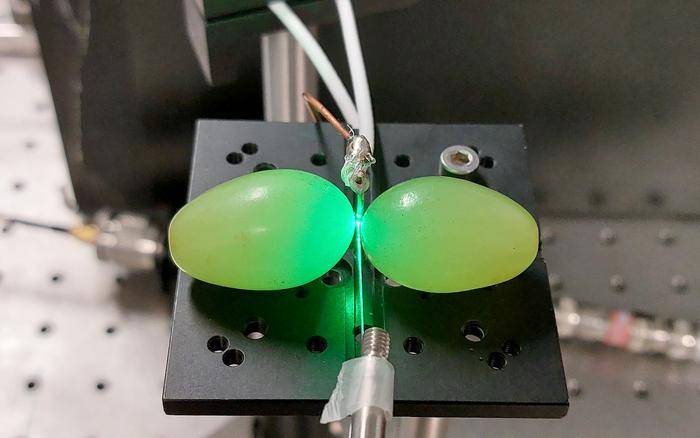Scientists Use Grapes to Juice Quantum Sensor Performance

Insider Brief
- Macquarie University researchers have discovered that supermarket grapes, due to their water content, can enhance microwave magnetic fields, potentially advancing the development of compact and cost-effective quantum sensors.
- The team demonstrated how nitrogen-vacancy centres in nano-diamonds, used as quantum sensors, detect twice as strong microwave magnetic fields when placed between precisely sized grapes.
- This study highlights the potential of water-based materials for quantum sensing applications, offering an alternative to traditional sapphire resonators and paving the way for more efficient quantum technologies.
- Image: Photo of the experimental setup to couple MWs to N- 𝑉s using grape dimers. A stripped optical fiber with N- 𝑉 spins, cantilevered from a rod, lies between two grapes. The grapes were positioned on a platform with a vertical straight copper wire, equidistant from each grape (Fawaz, Nair, Volz)
PRESS RELEASE — Macquarie University researchers have demonstrated how ordinary supermarket grapes can enhance the performance of quantum sensors, potentially leading to more efficient quantum technologies.
The study, published in Physical Review Applied on 20 December 2024, shows that pairs of grapes can create strong localised magnetic field hotspots of microwaves which are used in quantum sensing applications – a finding that could help develop more compact and cost-effective quantum devices.
“While previous studies looked at the electrical fields causing the plasma effect, we showed that grape pairs can also enhance magnetic fields, which are crucial for quantum sensing applications,” says lead author Ali Fawaz, a quantum physics PhD candidate at Macquarie University.
The research builds on viral social media videos showing grapes creating plasma – glowing balls of electrically charged particles – in microwave ovens.
While previous studies focused on electric fields, the Macquarie team examined magnetic field effects crucial for quantum applications.
The team used specialised nano-diamonds containing nitrogen-vacancy centres – atomic-scale defects that act as quantum sensors. These defects (one of the many defects giving diamonds their colour), behave like tiny magnets and can detect magnetic fields.
“Pure diamonds are colourless, but when certain atoms replace the carbon atoms, they can form so-called ‘defect’ centres with optical properties,” says study co-author Dr Sarath Raman Nair, who is a lecturer in quantum technology at Macquarie University.
“The nitrogen-vacancy centres in the nanodiamonds we used in this study act like tiny magnets that we can use for quantum sensing,” he says.
The team placed their quantum sensor – a diamond containing special atoms – on the tip of a thin glass fibre and positioned it between two grapes. By shining green laser light through the fibre, they could make these atoms glow red. The brightness of this red glow revealed the strength of the microwave field around the grapes.
“Using this technique, we found the magnetic field of the microwave radiation becomes twice as strong when we add the grapes,” says Fawaz.
Senior author Professor Thomas Volz, who heads the Quantum Materials and Applications Group at Macquarie’s School of Mathematical and Physical Sciences, says the findings unlock exciting possibilities for quantum technology miniaturisation.
“This research opens up another avenue for exploring alternative microwave resonator designs for quantum technologies, potentially leading to more compact and efficient quantum sensing devices,” he says.
The size and shape of the grapes proved crucial to the experiment’s success. The team’s experiments relied on precisely sized grapes – each approximately 27 millimetres long – to concentrate microwave energy at approximately the right frequency of the diamond quantum sensor.
Quantum sensing devices traditionally use sapphire for this purpose. However, the Macquarie team theorised that water might work even better. This made grapes, which are mostly water enclosed in a thin skin, perfect for testing their theory.
“Water is actually better than sapphire at concentrating microwave energy, but it’s also less stable and loses more energy in the process. That’s our key challenge to solve,” says Fawaz.
Looking beyond grapes, the researchers are now developing more reliable materials that could harness water’s unique properties, bringing us closer to more efficient sensing devices.
The work was supported by the Australian Research Council Centre of Excellence for Engineered Quantum Systems.
